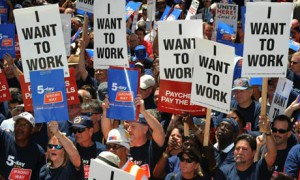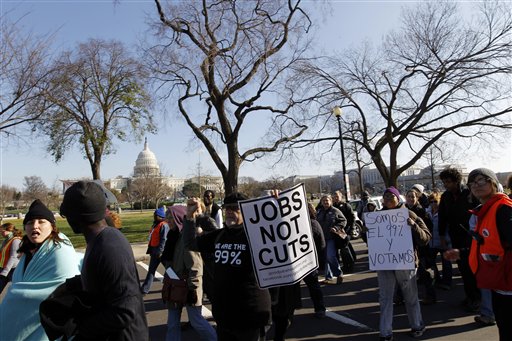The most recent employment data released in North America has reinvigorated the media’s coverage of the global economic recovery. The newly released December employment statistics were treated as major news not just for their distressing severity, but also because this setback was widely unexpected. It is disconcerting for those who experienced the onset of the 2008 financial crisis with little warning, that those tasked with monitoring the job market could be so blindsided by this turn of events. While everyone has been cautioned against drawing too many conclusions from one month of data, this stark break with the slow and steady growth in recent months is giving rise to serious questions that had subsided with the tempering of economic volatility. Right now this event is an outlier that certainly affects the thousands who lost their jobs, but may not portend weakness in the future. Nonetheless, even as an isolated incident these numbers, and the reaction to them, can expose some serious economic concerns that policymakers will be forced to contend with for some time.

Primarily, this recent development serves as a reminder of how anemic this recovery has been in the labour market. The growth of the stock market, best illustrated by the Dow Jones’ unprecedented heights, has hardly been matched in the broader economy. This is the defining disjuncture of the post-crisis environment and there is one fairly straightforward explanation for it: The 2008 crisis necessitated emergency action to save the vitally important financial sector which required immense public funds in the United States and elsewhere. After undertaking such expensive measures, governments felt compelled to establish a sense of balance to their finances by implementing austerity measures. Reduced to the simplest terms, this amounts to a transfer of funds away from the public sector in order to save the private sector. If the major stock indices are any indication, this was an effective approach. Fears of a far greater collapse of the market were gradually allayed as stocks and businesses began to stabilize and recoup their losses. But it is no coincidence that the labour market has yet to fully recover. Quantitatively, unemployment levels remain high especially among youth, and equally important, but often understated qualitative changes have also occurred.
Most reporting of the recent jobs numbers focus on the unemployment rate. Importantly, this does not refer to the entire jobless population. In addition to some other excluded groups, the unemployment rate does not include retirees, the very young, students, or discouraged workers who have given up on their search for a job. In one sense these exclusions are reasonable, retirees are by definition not employed, students are engaged in other beneficial pursuits, and the very young should not be expected to work. However, at least some of these excluded categories can be closely linked to the availability of jobs. Retirees may have been given buy-outs from a downsizing workplace or may have retired sooner than expected due to a lack of job prospects. Similarly, students may be attending school longer than they planned to avoid entering a weak job market at the beginning of their careers. The least tenable exclusion is the category of discouraged workers who have abandoned or suspended their job search. This deficiency is often noted in media reports making use of unemployment numbers, but the general usefulness of these statistics for a mass audience is rarely questioned. Although strictly defined unemployment statistics are certainly useful for economists and investors, they take on a euphemistic quality when presented to an audience that simply wants to gain a general understanding of how much of the population is working. When the less prominent but more comprehensive employment-to-population ratio is consulted, audiences are confronted with an even gloomier picture.
An analysis of the job market that goes beyond unemployment rates reveals an important trend that has defined the recovery. The job market has seen an increase in what economists and investors often call “flexibility”, and what pro-labour commentators refer to as “precariousness”. Whether one prefers the euphemism or the pejorative, these two terms share the same basic definition: the ability of a business to control and adjust the size of its labour force by hiring and firing workers quickly and easily, the ability of a business to remunerate employees as it sees fit, and the ability to establish working conditions with minimal regulatory burdens.
The many proponents of increased flexibility argue that it is essential in order to create globally competitive economic sectors, establish profitable enterprises, and maximize often ephemeral advantages in an extremely dynamic economy. In other words, it is argued that when businesses are overburdened by labour, their competitiveness, profitability, and innovation are weakened. This undermines the economy as a whole, negatively impacting everyone including workers. Equally vocal critics of precariousness, meanwhile, argue that it creates increases in inequality by allowing businesses to repress wages (and potentially consumer demand) in order to stimulate ever greater profits. In the eyes of these critics, a flexible labour market might create growth, but to the disproportionate benefit of an already privileged few.
Whichever side of the debate one finds more persuasive, the emerging reality of the labour market is becoming increasingly apparent. Even before the startling December numbers were published, it was clear that the jobs behind the steady decline of the unemployment rate were not the same as existed before. They were disproportionately part-time, temporary, low-skilled, and low wage positions. Barring an unexpected sustained increase in official unemployment, this is the change that governments will need to confront. Simply put, it seems that the job market may not be recovering what was lost, but is instead transforming into something different. This creates new challenges that old policies may not be able to effectively address.
During the often booming years in the 1990s and 2000s, western governments preached the virtues of labour market flexibility to the global south. Structural adjustment programs explicitly aimed at minimizing government interference in the economy were incentivized by the World Bank through its conditional lending programs, and many countries had their labour markets significantly transformed. Now it seems that increases in flexibility have been accelerated within post-industrial western economies. Issues of volatility and insecurity will likely become incorporated into broader debates about societal fairness and it remains to be seen whether western governments will effectively adapt to this change.




